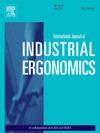影响粗糙度感知的潜在因素综述
IF 3
2区 工程技术
Q2 ENGINEERING, INDUSTRIAL
International Journal of Industrial Ergonomics
Pub Date : 2025-07-01
DOI:10.1016/j.ergon.2025.103778
引用次数: 0
摘要
触觉反馈在扩展现实中的重要性因其增强沉浸式用户体验的潜力而受到越来越多的关注。然而,触觉反馈的实现仍然面临着各种各样的挑战,这不仅是因为技术上的困难,还因为所涉及的认知过程尚不清楚。此外,由于触觉刺激、标本提供和实验环境的不同,以往的粗糙度感知研究是碎片化的。因此,全面了解粗糙度感知是必不可少的。本研究回顾了现有文献,以确定影响粗糙度感知的关键潜在因素,并基于用户体验框架将其分为四个主要元素:交互、系统、用户和上下文。交互涉及受试者如何体验粗糙度,系统涉及粗糙度刺激的实施,用户代表受试者感知粗糙度的特征,而上下文涉及粗糙度感知的环境。结果,确定了32个因素和8个因素组,并进行了系统组织,以更好地了解它们对粗糙度感知的影响。通过在用户体验框架内构建这些因素,本研究为更全面地理解粗糙度感知提供了基础。此外,这些发现为更广泛的触觉体验领域提供了见解,并提出了在触觉技术开发、虚拟现实和人机交互等各个领域的潜在应用。本文章由计算机程序翻译,如有差异,请以英文原文为准。
A review of potential factors affecting roughness perception
The importance of tactile feedback in extended reality has gained increasing attention for its potential to enhance immersive user experience. However, the implementation of tactile feedback still faces various challenges not only due to technical difficulties but also because the cognitive processes involved remain unclear. Additionally, previous studies on roughness perception are fragmented due to varying implementations of tactile stimuli, specimen provision, and experimental environments. Therefore, a comprehensive understanding of roughness perception is essential. This study reviews existing literature to identify the key potential factors affecting roughness perception, categorizing them into four main elements based on the User Experience Framework: Interaction, System, User, and Context. Interaction refers to how subjects experience roughness, System pertains to the implementation of roughness stimuli, User represents the characteristics of subjects perceiving roughness, and Context addresses the environment of roughness perception. As a result, 32 factors and 8 factor groups were identified and systematically organized to better understand their effects on roughness perception. By structuring these factors within the User Experience Framework, this study provides a foundation for a more comprehensive understanding of roughness perception. Furthermore, these findings offer insights into the broader domain of tactile experience, suggesting potential applications in various fields such as haptic technology development, virtual reality, and human-computer interaction.
求助全文
通过发布文献求助,成功后即可免费获取论文全文。
去求助
来源期刊
CiteScore
6.40
自引率
12.90%
发文量
110
审稿时长
56 days
期刊介绍:
The journal publishes original contributions that add to our understanding of the role of humans in today systems and the interactions thereof with various system components. The journal typically covers the following areas: industrial and occupational ergonomics, design of systems, tools and equipment, human performance measurement and modeling, human productivity, humans in technologically complex systems, and safety. The focus of the articles includes basic theoretical advances, applications, case studies, new methodologies and procedures; and empirical studies.

 求助内容:
求助内容: 应助结果提醒方式:
应助结果提醒方式:


